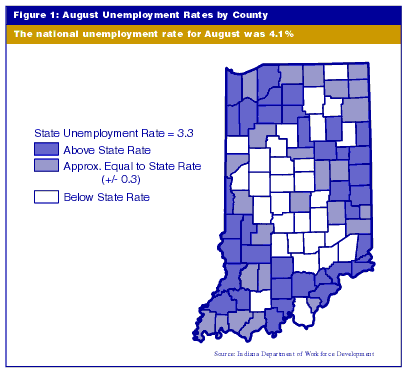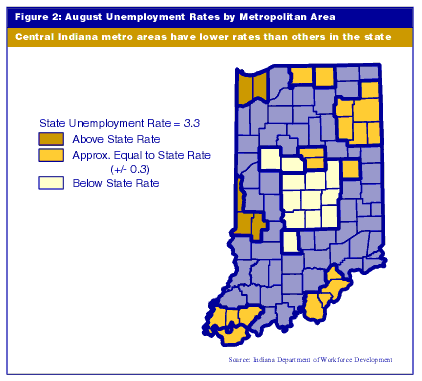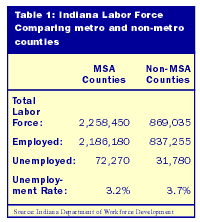Unemployment Rate Takes Seasonal Dip
Indiana's unemployment rate fell to 3.3% in August, down from 3.7% in July. A dip in the jobless rate is common in August, as the employment situation adjusts to the beginning of the school year.
Figure 1 on page 9 shows the August unemployment rates by county, ranging from a high of 8.3% in Switzerland County to a low of 1.5% in Hamilton County and 1.6% in Boone County.
Click on map to see larger version with data.

The Indiana labor force in August was estimated at 3.13 million people,
according to figures released by the Indiana Department of Workforce Development.
This represents a 1.2% drop from the previous month. IDWD estimated that the
number of employed workers stood at 3.02 million, down about 28,000, or 0.9%,
from July.
The number of unemployed Hoosiers also dropped in August to 104,000. That
was 11,700 lower than the previous month's jobless number. All data are unadjusted
for seasonality.
The estimated labor force contracted by more than 1% but the number employed shrank by less than 1%. Therefore, the number of unemployed workers declined. Indiana's August unemployment rate (3.3%) remained significantly below the national rate (4.1%).
Metro Areas Post Low Unemployment
Most metropolitan areas in Indiana boast unemployment rates lower than the state or national averages. That pattern continued in August. The Indiana Department of Workforce Development tallies employment data for 12 metropolitan areas in Indiana. Figure 2 shows the August unemployment rates for these 12 areas.
Click on map to see larger version with data.

In general, metro areas in Indiana tend to have lower unemployment rates than more rural counties. Of our state's 92 counties, 37 are included in metropolitan statistical areas (MSAs). Of these 37 metropolitan counties, 22—about 60%—produced lower unemployment rates in August than the Indiana state average.
Table 1 shows how all metro area counties together stack up against all non-metro area counties taken together. For August, the rural counties averaged 3.7% unemployment, slightly higher than the statewide rate. Metro counties as a group had an average unemployment rate of just 3.2%.

Compared to the 4.1% U.S. unemployment rate in August, all but two Indiana metro areas exhibited lower rates. Terre Haute unemployment was estimated at 4.8% and Gary came in at 4.3%.
The Indiana metro area with the lowest August unemployment rate was Lafayette, with a rate of only 2.2%. This places Lafayette well below the Indiana state average unemployment rate of 3.3%. Of the 337 national metro areas whose unemployment rates are published by the U.S. Bureau of Labor Statistics, only 29 had a lower unemployment rate than Lafayette. Just under Lafayette, at 2.1%, was Iowa City, Iowa. Tied with Lafayette at 2.2% was State College, Pa.
The second lowest August unemployment rate in the state was 2.6%, shared by Bloomington and Indianapolis. Others around the country at 2.6% were Knoxville, Tenn., and Orlando, Fla. Fort Collins-Loveland, Colo., trailed slightly with a 2.9% rate.
What's the Difference Between Employment and a Job?
Unemployment reports often cite the number of people employed at a given time. Other reports talk about the number of jobs. And the numbers don't come out the same. What's the difference?
"The difference is where the person lives versus where the job is located," said Charles Mazza, director of Labor Market Information at the Indiana Department of Workforce Development. Published reports often use the word "employment" to refer to both categories of data, which may create some confusion.
Data for the number of people employed and unemployed, explained Mazza, are based on where people live. A Lake County resident who commutes to Porter County to work will show up in the employed statistics for Lake County. So unemployment rates always measure the level of unemployment among residents of a county.
Jobs are another measure of people at work. But jobs, also termed employment, are counted in the county where the work is located. That same Lake County commuter working in Porter County will be part of Porter County's employment number. Therefore, Indiana residents who hold jobs in Illinois, Michigan, Kentucky or Ohio are not part of Indiana's jobs total. "Unemployment rates are by place of residence," said Mazza. "Employment, or the jobs number, is by place of work."
IN Context reports on employed and unemployed by county of residence in the section titled "IN Local Areas." The section titled "IN the Workforce" reports on employment data, the jobs number by place of work.
